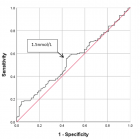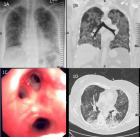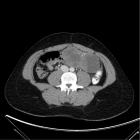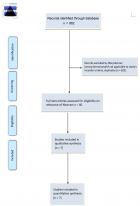Abstract
Mini Review
The necessity of emotion management for the general public: a comparison of diagnostic changes in two anger-related psychiatric disorders
Yoorim Hyun and Myoungsoon You*
Published: 23 December, 2022 | Volume 6 - Issue 1 | Pages: 048-051
Although emotion management is essential to mental health, public health has not paid much attention to emotional conditions or disorders. By analyzing a nine-year diagnostic trend and sociodemographic characteristics of two mental disorders: Hwabyung and Intermittent Explosive Disorder (IED), this study demonstrated the importance of managing emotions precautionarily.
Data reconstructed from the National Health Insurance Service were used to analyze the yearly diagnostic trend in the two mental disorders characterized by anger.
Hwabyung was more common among women and middle-aged individuals, despite the varied number of diagnoses by year. Between 2010 and 2018, IED diagnoses gradually rose, with the average rate of increase the highest in the 20s for male IED diagnoses in 2017. The low prevalence of the IED in Korea compared to other Western countries and the gender and age differences in both Hwabyung and IED diagnoses suggest the role of cultural influences related to emotions (or emotional management).
Especially in light of the world’s emphasis on resilience to COVID-19, these results indicate how public emotional management is essential during stressful situations. The results also highlight the need for community mental health programs tailored to gender and age.
Read Full Article HTML DOI: 10.29328/journal.apmh.1001044 Cite this Article Read Full Article PDF
Keywords:
Hwabyung; Intermittent explosive disorder; Emotion management; Anger; Mental health
References
- Nathwani S, Rahman N. The 3 P's model enhancing patient safety during the COVID-19 pandemic. Oral Surg. 2021 Aug;14(3):246-254. doi: 10.1111/ors.12607. Epub 2021 Feb 17. PMID: 33821170; PMCID: PMC8013890.
- ICD-10-CM 2021: The Complete Official Codebook (ICD-10-CM the Complete Official Codebook). American Medical Association .2021.
- Lee J, Wachholtz A, Choi KH. A Review of the Korean Cultural Syndrome Hwa-Byung: Suggestions for Theory and Intervention. Asia Taepyongyang Sangdam Yongu. 2014 Jan;4(1):49. doi: 10.18401/2014.4.1.4. PMID: 25408922; PMCID: PMC4232959.
- Min SK. Hwabyung in Korea: Culture and dynamic analysis. World cultural psychiatry research review. 2009; 4(1): 12-21.
- American Psychiatric.Association A. American Psychiatric Association. Diagnostic and statistical manual of mental disorders: DSM-5. Washington, DC: American psychiatric association. 2013.
- Ciesinski NK, Drabick DAG, McCloskey MS. A latent class analysis of intermittent explosive disorder symptoms. J Affect Disord. 2022 Apr 1;302:367-375. doi: 10.1016/j.jad.2022.01.099. Epub 2022 Jan 29. PMID: 35101522.
- Coccaro EF, Lee R, Coussons-Read M. Elevated plasma inflammatory markers in individuals with intermittent explosive disorder and correlation with aggression in humans. JAMA Psychiatry. 2014 Feb;71(2):158-65. doi: 10.1001/jamapsychiatry.2013.3297. PMID: 24352431.
- Fettich KC, McCloskey MS, Look AE, Coccaro EF. Emotion regulation deficits in intermittent explosive disorder. Aggress Behav. 2015 Jan; 41(1):25-33. doi: 10.1002/ab.21566. PMID: 27539871.
- McCloskey MS, Berman ME, Noblett KL, Coccaro EF. Intermittent explosive disorder-integrated research diagnostic criteria: convergent and discriminant validity. J Psychiatr Res. 2006 Apr;40(3):231-42. doi: 10.1016/j.jpsychires.2005.07.004. Epub 2005 Sep 8. PMID: 16153657.
- McCloskey MS, Lee R, Berman ME, Noblett KL, Coccaro EF. The relationship between impulsive verbal aggression and intermittent explosive disorder. Aggress Behav. 2008 Jan-Feb;34(1):51-60. doi: 10.1002/ab.20216. PMID: 17654692.
- Coccaro EF, McCloskey MS. Phenomenology of impulsive aggression and intermittent explosive disorder. In Intermittent Explosive Disorder. 2019; 37-65. Academic Press.
- Ma J, Liu Y, Ma L, Huang S, Li H, You C. RNF213 polymorphism and Moyamoya disease: A systematic review and meta-analysis. Neurol India. 2013 Jan-Feb; 61(1):35-9. doi: 10.4103/0028-3886.107927. PMID: 23466837.
- Kessler RC, Coccaro EF, Fava M, Jaeger S, Jin R, Walters E. The prevalence and correlates of DSM-IV intermittent explosive disorder in the National Comorbidity Survey Replication. Arch Gen Psychiatry. 2006 Jun;63(6):669-78. doi: 10.1001/archpsyc.63.6.669. PMID: 16754840; PMCID: PMC1924721.
- Seo MK, Rhee MK. Mental health literacy and vulnerable group analysis of Korea. Korean Journal of Social Welfare 2013; 65:313-334.
- Ng CH. The stigma of mental illness in Asian cultures. Aust N Z J Psychiatry. 1997 Jun;31(3):382-90. doi: 10.3109/00048679709073848. PMID: 9226084.
- Shea M, Yeh CJ. Asian American Students' cultural values, stigma, and relational self-construal: correlates of attitudes toward professional help-seeking. J Ment Health Couns. 2008; 30:157–72.
- Yang LH. Application of mental illness stigma theory to Chinese societies: synthesis and new directions. Singapore Med J. 2007 Nov;48(11):977-85. PMID: 17975685.
- Yang LH, Purdie-Vaughns V, Kotabe H, Link BG, Saw A, Wong G. Culture, threat, and mental illness stigma: identifying culture-specific threat among Chinese-American groups. Soc Sci Med. 2013; 88:56–67.
- Jang Y, Kim G, Hansen L, Chiriboga DA. Attitudes of older Korean Americans toward mental health services. J Am Geriatr Soc. 2007 Apr;55(4):616-20. doi: 10.1111/j.1532-5415.2007.01125.x. PMID: 17397442; PMCID: PMC1986774.
- Jang Y, Chiriboga DA, Okazaki S. Attitudes toward mental health services: age-group differences in Korean American adults. Aging Ment Health. 2009 Jan;13(1):127-34. doi: 10.1080/13607860802591070. PMID: 19197698; PMCID: PMC2737391.
- Bonabi H, Müller M, Ajdacic-Gross V, Eisele J, Rodgers S, Seifritz E, Rössler W, Rüsch N. Mental Health Literacy, Attitudes to Help Seeking, and Perceived Need as Predictors of Mental Health Service Use: A Longitudinal Study. J Nerv Ment Dis. 2016 Apr;204(4):321-4. doi: 10.1097/NMD.0000000000000488. PMID: 27015396.
- Hur YM.Genetic and Environmental Influences on Hwabyung-Personality in South Korean Adolescents and Young Adults. Korean Journal of Stress Research. 2020;28(1), 25-32.
- Cox SJ, Mezulis AH, Hyde JS. The influence of child gender role and maternal feedback to child stress on the emergence of the gender difference in depressive rumination in adolescence. Dev Psychol. 2010 Jul;46(4):842-52. doi: 10.1037/a0019813. PMID: 20604606.
- Kingsbury MK, Coplan RJ. Mothers’ gender-role attitudes and their responses to young children’s hypothetical display of shy and aggressive behaviors. Sex roles. 2012; 66(7): 506-517.
- Park IJ, Kim PY, Cheung RY, Kim M. The role of culture, family processes, and anger regulation in Korean American adolescents’ adjustment problems. American Journal of Orthopsychiatry. 2010;80(2): 258.
- Kwon HI, Lee SY, Kwon JH. Hwabyung symptoms and anger expression in relation to submissive behavior and external entrapment in a married couple. The Korean Journal of Woman Psychology.2012; 579-595.
- Kwon JH, Kim JW, Park DG, Lee MS, Min SK,Kwon HI, Development and validation of the Hwabyung scale. The Korean Journal of Clinical Psychology.2008; 237-252.
- Min SK, A study of the concept of Hwabyung. J Korean Neuropsychiatr Assoc.1989; 604-616.
- Kim E, Hogge I, Ji P, Shim YR, Lothspeich C. Hwa-Byung among middle-aged Korean women: family relationships, gender-role attitudes, and self-esteem. Health Care Women Int. 2014 May;35(5):495-511. doi: 10.1080/07399332.2012.740114. Epub 2013 Apr 29. PMID: 23627346.
- Shin HS, Shin Ds. Korean women’s causal perceptions of hwabyung. Korean J Women Health Nurs. 2004; 10:283–90. doi: 10.4069/kjwhn.2004.10.4.283.
- Kim E, Seo J, Paik H, Sohn S. The Effectiveness of Adlerian Therapy for Hwa-Byung in Middle-Aged South Korean Women. The Counseling Psychologist. 2020; 48(8):1082-1108.
- Jang JM, Park JI, Oh KY, Lee KH, Kim MS, Yoon MS, Ko SH, Cho HC, Chung YC. Predictors of suicidal ideation in a community sample: roles of anger, self-esteem, and depression. Psychiatry Res. 2014 Apr 30;216(1):74-81. doi: 10.1016/j.psychres.2013.12.054. Epub 2014 Jan 9. PMID: 24507544.
- An S, Lee H. An Exploratory Study on How and Why Young and Middle-aged Adults Disclose Depressive Feelings to Others: Focusing on the Influence of Perception of Social Norms Journal of Korean Academy of Community Health Nursing. 2021; 32(1):12-23.
Figures:

Figure 1

Figure 2
Similar Articles
-
Mental health promotion program in the workplace with focus on transportOlaf Jensen*,Fereshteh Baygi,George Charalambous,Agnes Flores,Lise Hedegaard Laursen,David Lucas,Debbie Andrioti. Mental health promotion program in the workplace with focus on transport. . 2019 doi: 10.29328/journal.apmh.1001004; 3: 001-011
-
Diseases of the mental sphere revealed by the psychiatrist at contingent of patients of the consultative outpatient admissionShapovalova LA*,Shapovalov КA. Diseases of the mental sphere revealed by the psychiatrist at contingent of patients of the consultative outpatient admission. . 2019 doi: 10.29328/journal.apmh.1001005; 3: 012-019
-
Staff experiences of the REFOCUS intervention to support recovery in mental health: A qualitative study nested within a cluster randomized controlled trialM Leamy*,R Macpherson,G Riley,K Sanger,E Clarke,V Bird,M Janosik,H Jordan,C Le Boutillier,J Williams,M Slade. Staff experiences of the REFOCUS intervention to support recovery in mental health: A qualitative study nested within a cluster randomized controlled trial. . 2020 doi: 10.29328/journal.apmh.1001014; 4: 024-032
-
Implications on mental health by the coronavirus disease 2019 (COVID-19) pandemic: The role of general practitionerJose Luis Turabian*. Implications on mental health by the coronavirus disease 2019 (COVID-19) pandemic: The role of general practitioner. . 2020 doi: 10.29328/journal.apmh.1001016; 4: 035-041
-
Role of community health fairs in providing health services, improving health of rural residentsTrina Aguirre*,Justine Jobman,Ann Koehler,Wendy Wells,Leeza Struwe. Role of community health fairs in providing health services, improving health of rural residents. . 2020 doi: 10.29328/journal.apmh.1001017; 4: 042-045
-
Targeted community outreach events to deliver healthcare to diverse rural populationsTrina Aguirre*,Nancy Meier,Kelly Betts,Ann Koehler. Targeted community outreach events to deliver healthcare to diverse rural populations. . 2020 doi: 10.29328/journal.apmh.1001021; 4: 060-062
-
Health professional stress during COVID-19 pandemicFatiha Bennaoui*,Nadia Ei Idrissi Slitine,Fadl Mrabih Rabou Maoulainine. Health professional stress during COVID-19 pandemic. . 2020 doi: 10.29328/journal.apmh.1001023; 4: 070-072
-
Prevalence of PTSD symptoms in children: The cost of the inadequate mental health system in PakistanIqra Mushtaque*. Prevalence of PTSD symptoms in children: The cost of the inadequate mental health system in Pakistan. . 2022 doi: 10.29328/journal.apmh.1001040; 6: 029-031
-
The necessity of emotion management for the general public: a comparison of diagnostic changes in two anger-related psychiatric disordersYoorim Hyun,Myoungsoon You*. The necessity of emotion management for the general public: a comparison of diagnostic changes in two anger-related psychiatric disorders. . 2022 doi: 10.29328/journal.apmh.1001044; 6: 048-051
-
Assessment of self-injurious behavior in major depressive disorder: a case reportElena-Rodica Popescu*,Bianca Augusta Oroian,Vasile Chiriță,Roxana Chiriță. Assessment of self-injurious behavior in major depressive disorder: a case report. . 2023 doi: 10.29328/journal.apmh.1001046; 7: 004-009
Recently Viewed
-
Sensitivity and Intertextile variance of amylase paper for saliva detectionAlexander Lotozynski*. Sensitivity and Intertextile variance of amylase paper for saliva detection. J Forensic Sci Res. 2020: doi: 10.29328/journal.jfsr.1001017; 4: 001-003
-
Extraction of DNA from face mask recovered from a kidnapping sceneBassey Nsor*,Inuwa HM. Extraction of DNA from face mask recovered from a kidnapping scene. J Forensic Sci Res. 2022: doi: 10.29328/journal.jfsr.1001029; 6: 001-005
-
The Ketogenic Diet: The Ke(y) - to Success? A Review of Weight Loss, Lipids, and Cardiovascular RiskAngela H Boal*, Christina Kanonidou. The Ketogenic Diet: The Ke(y) - to Success? A Review of Weight Loss, Lipids, and Cardiovascular Risk. J Cardiol Cardiovasc Med. 2024: doi: 10.29328/journal.jccm.1001178; 9: 052-057
-
Could apple cider vinegar be used for health improvement and weight loss?Alexander V Sirotkin*. Could apple cider vinegar be used for health improvement and weight loss?. New Insights Obes Gene Beyond. 2021: doi: 10.29328/journal.niogb.1001016; 5: 014-016
-
Maximizing the Potential of Ketogenic Dieting as a Potent, Safe, Easy-to-Apply and Cost-Effective Anti-Cancer TherapySimeon Ikechukwu Egba*,Daniel Chigbo. Maximizing the Potential of Ketogenic Dieting as a Potent, Safe, Easy-to-Apply and Cost-Effective Anti-Cancer Therapy. Arch Cancer Sci Ther. 2025: doi: 10.29328/journal.acst.1001047; 9: 001-005
Most Viewed
-
Evaluation of Biostimulants Based on Recovered Protein Hydrolysates from Animal By-products as Plant Growth EnhancersH Pérez-Aguilar*, M Lacruz-Asaro, F Arán-Ais. Evaluation of Biostimulants Based on Recovered Protein Hydrolysates from Animal By-products as Plant Growth Enhancers. J Plant Sci Phytopathol. 2023 doi: 10.29328/journal.jpsp.1001104; 7: 042-047
-
Sinonasal Myxoma Extending into the Orbit in a 4-Year Old: A Case PresentationJulian A Purrinos*, Ramzi Younis. Sinonasal Myxoma Extending into the Orbit in a 4-Year Old: A Case Presentation. Arch Case Rep. 2024 doi: 10.29328/journal.acr.1001099; 8: 075-077
-
Feasibility study of magnetic sensing for detecting single-neuron action potentialsDenis Tonini,Kai Wu,Renata Saha,Jian-Ping Wang*. Feasibility study of magnetic sensing for detecting single-neuron action potentials. Ann Biomed Sci Eng. 2022 doi: 10.29328/journal.abse.1001018; 6: 019-029
-
Pediatric Dysgerminoma: Unveiling a Rare Ovarian TumorFaten Limaiem*, Khalil Saffar, Ahmed Halouani. Pediatric Dysgerminoma: Unveiling a Rare Ovarian Tumor. Arch Case Rep. 2024 doi: 10.29328/journal.acr.1001087; 8: 010-013
-
Physical activity can change the physiological and psychological circumstances during COVID-19 pandemic: A narrative reviewKhashayar Maroufi*. Physical activity can change the physiological and psychological circumstances during COVID-19 pandemic: A narrative review. J Sports Med Ther. 2021 doi: 10.29328/journal.jsmt.1001051; 6: 001-007

HSPI: We're glad you're here. Please click "create a new Query" if you are a new visitor to our website and need further information from us.
If you are already a member of our network and need to keep track of any developments regarding a question you have already submitted, click "take me to my Query."


















































































































































